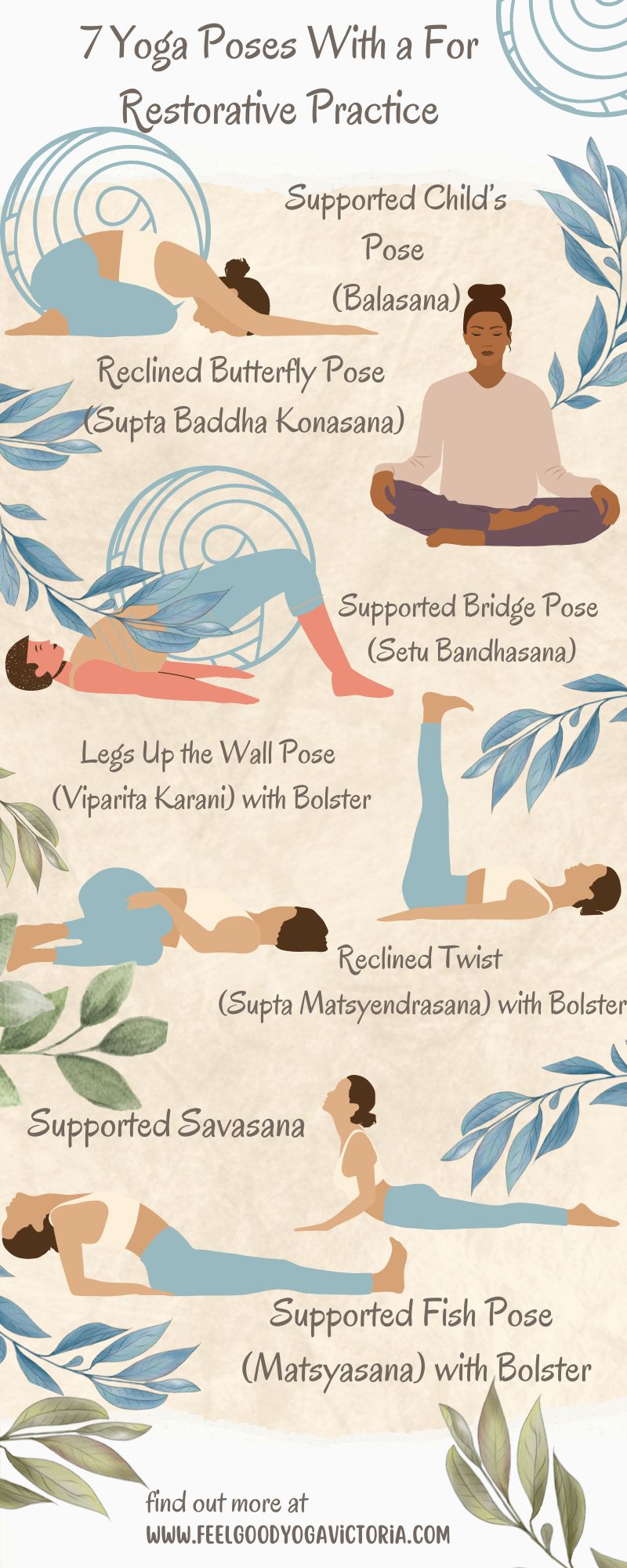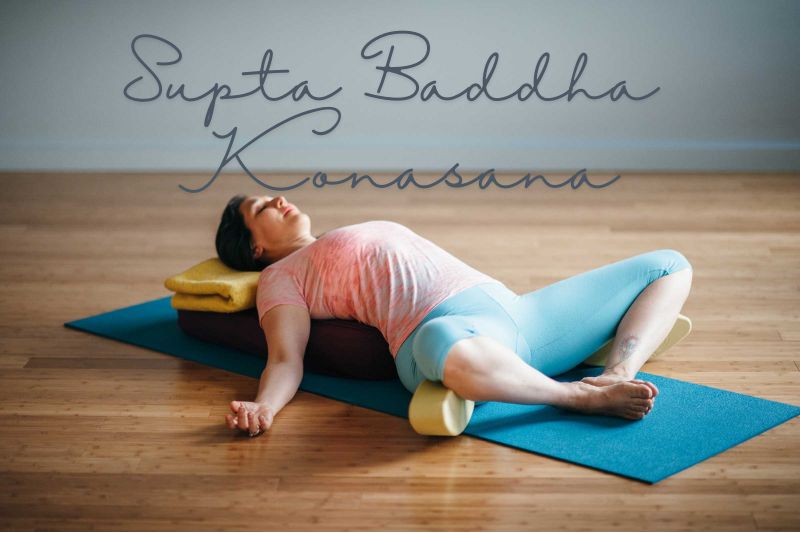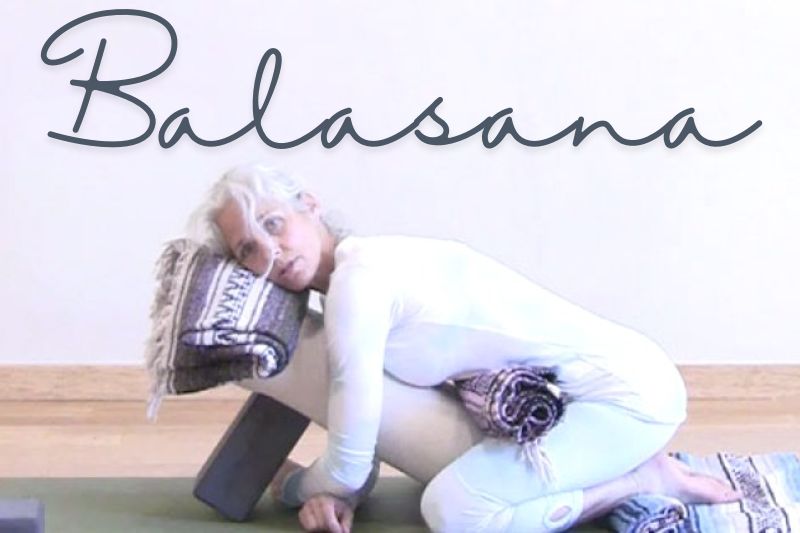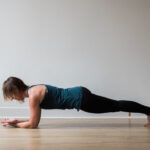Restorative yoga is like the slow dance of the yoga world. It’s a practice where the art of relaxation is honored, inviting you to let go of tension and melt into a state of deep, replenishing rest.
Unlike other forms of yoga that might leave you sweating or challenge your endurance, restorative yoga is all about finding comfort and ease in each pose, often with the help of props like bolsters, blankets, and blocks. The goal? To help your body relax completely, allowing your nervous system to reset and rejuvenate.

Supported Child’s Pose (Balasana)
The most common example of yoga poses, Supported Child’s Pose is like a warm hug for your body. It’s a grounding posture that stretches the lower back, hips, and thighs while calming the mind and reducing stress. Adding a bolster to this pose enhances the comfort, allowing you to rest deeply and fully.
How to Do It: Start on your hands and knees, with your knees wide apart and big toes touching. Place the bolster lengthwise in front of you, aligned with your torso. Slowly lower your torso onto the bolster, extending your arms forward or resting them alongside the bolster. Turn your head to one side, and after a few minutes, switch sides.
Benefits:
- Stress Relief: By allowing your body to drape over the bolster, this pose activates the parasympathetic nervous system, promoting relaxation.
- Lower Back Relief: The gentle forward fold stretches the lower back, relieving tension and discomfort in this area.
- Hip Opener: The wide knee position helps to open up the hips, which can become tight from prolonged sitting or strenuous activity.
Pro Tip: If your hips are tight, place a folded blanket under your hips for additional support, ensuring that you can relax fully into the pose.
Reclined Butterfly Pose (Supta Baddha Konasana)

Reclined Butterfly Pose is a restorative classic that opens up the hips, chest, and inner thighs while encouraging deep relaxation. When supported by a bolster, this pose feels like floating on a cloud.
How to Do It: Sit with the soles of your feet together and let your knees fall open to the sides. Position the bolster behind you, lengthwise along your spine. Lean back onto the bolster, letting your arms fall to the sides with palms facing up. Your knees can be supported with blocks or blankets if they don’t comfortably reach the floor.
Benefits:
- Chest Opener: This pose gently opens the chest and shoulders, counteracting the hunched posture many of us adopt throughout the day.
- Hip Flexibility: The external rotation of the hips encourages flexibility and releases tension in the inner thighs.
- Emotional Release: Opening the heart center can also facilitate the release of pent-up emotions, leaving you feeling lighter and more at ease.
Pro Tip: For added comfort, place a folded blanket under your head or use eye pillows to block out light and deepen the sense of relaxation.
Supported Bridge Pose (Setu Bandhasana)
The Supported Bridge Pose is a restorative inversion that can help rejuvenate the body and mind. When practiced with a bolster, this pose provides gentle support to the lower back while still offering the benefits of a mild inversion.
How to Do It: Lie on your back with your knees bent and feet flat on the floor, hip-width apart. Place the bolster under your sacrum (the triangular bone at the base of your spine). Rest your arms by your sides, palms facing down, or place them on your belly. Relax into the pose, allowing the bolster to support the weight of your pelvis.
Benefits:
- Spinal Support: The bolster helps maintain the natural curve of the lower back, providing gentle traction to the spine.
- Circulation Boost: As an inversion, this pose encourages blood flow to the upper body, which can help revitalize the mind and relieve fatigue.
- Digestive Aid: This gentle backbend can stimulate the abdominal organs, aiding in digestion and relieving bloating.
Pro Tip: To make this pose even more restorative, place a blanket under your shoulders and head for added support and comfort.
Legs Up the Wall Pose (Viparita Karani) with Bolster

This pose is a go-to for anyone looking to unwind and restore. The Legs Up the Wall Pose is a mild inversion that calms the nervous system, reduces swelling in the legs, and helps you feel more grounded. Adding a bolster under the hips elevates the pose, making it even more relaxing.
How to Do It: Sit sideways against a wall with your bolster next to your hips. Swing your legs up onto the wall as you lower your back onto the floor, adjusting the bolster under your hips. Your legs should be resting vertically against the wall, with your body forming an L shape. Let your arms relax by your sides, palms facing up.
Benefits:
- Circulation Improvement: This inversion encourages venous blood return to the heart, which can be particularly soothing after a long day of standing or sitting.
- Lower Body Relaxation: Elevating the legs reduces swelling and fatigue in the lower extremities, providing relief from conditions like varicose veins.
- Nervous System Calm: By elevating the legs, this pose helps calm the mind and nervous system, promoting a state of deep relaxation.
Pro Tip: If your hamstrings are tight, move further away from the wall, bending your knees slightly for comfort.
Reclined Twist (Supta Matsyendrasana) with Bolster
This pose is a gentle spinal twist that stretches the back, massages the abdominal organs, and helps release tension in the body. Using a bolster in the Reclined Twist enhances the stretch and supports the spine, allowing you to relax completely.
How to Do It: Lie on your back with your knees bent and feet flat on the floor. Draw your knees towards your chest and slowly lower them to one side, placing a bolster under your knees for support. Extend your arms out to the sides in a T-shape, with palms facing up. Turn your head in the opposite direction of your knees, and relax into the twist.
Benefits:
- Spinal Relief: This gentle twist helps to decompress the spine, releasing tension in the back and shoulders.
- Digestive Stimulation: The twisting motion massages the abdominal organs, which can aid in digestion and relieve bloating.
- Deep Relaxation: Twisting poses help to wring out physical and emotional tension, leaving you feeling more balanced and at peace.
Pro Tip: For a deeper stretch, you can hug the bolster closer to your torso, or if you prefer a gentler twist, move the bolster further away from your body.
Supported Savasana
Savasana, or Corpse Pose, is the ultimate restorative pose. It’s a time to fully surrender and absorb the benefits of your practice. Adding a bolster to your Savasana can elevate your experience, making it even more relaxing and supportive.
How to Do It: Lie flat on your back with your legs extended and arms resting by your sides, palms facing up. Place a bolster under your knees to relieve pressure on the lower back and encourage the natural curve of the spine. You can also place a folded blanket under your head and neck for added support.
Benefits:
- Total Relaxation: Savasana allows your body and mind to fully integrate the benefits of your practice, leaving you refreshed and rejuvenated.
- Spine Alignment: The bolster helps maintain the natural alignment of your spine, reducing any residual tension in the lower back.
- Stress Reduction: This pose is designed to induce a state of deep relaxation, helping to lower stress levels and promote a sense of inner peace.
Pro Tip: Use an eye pillow or cover your eyes with a soft cloth to block out light and enhance the calming effects of Savasana.
Supported Fish Pose (Matsyasana) with Bolster

Supported Fish Pose is a heart-opening backbend that stretches the chest, throat, and shoulders. When practiced with a bolster, it becomes a restorative pose that opens the front body while providing gentle support to the spine.
How to Do It: Sit with your legs extended in front of you. Place a bolster lengthwise behind you and slowly lower your back onto it, allowing your head to rest comfortably. Let your arms fall to the sides with palms facing up. You can keep your legs extended or bend your knees with feet flat on the floor.
Benefits:
- Chest and Shoulder Opener: This pose gently opens the chest and shoulders, counteracting the effects of poor posture and allowing for deeper breathing.
- Throat Chakra Activation: The gentle stretch to the throat and neck can help stimulate the throat chakra, promoting clear communication and self-expression.
- Emotional Balance: As a heart-opening pose, Supported Fish can help release emotional blockages, leaving you feeling more balanced and at ease.
Pro Tip: To make this pose even more luxurious, place a folded blanket under your head or use a second bolster under your knees for added support.
Final Words
Restorative yoga is a practice that invites you to slow down, breathe deeply, and let go of tension—both physical and mental. With the help of a bolster, you can make your restorative practice even more comforting and supportive, allowing you to fully embrace the art of relaxation. Whether you’re seeking relief from stress, tension, or simply looking to enhance your overall well-being, these seven poses offer a pathway to inner peace and restoration.
Remember, the beauty of restorative yoga lies in its simplicity. There’s no need to push or strain—just let the bolster do the work, supporting you as you sink into each pose and let go of whatever no longer serves you. So the next time you roll out your mat, grab a bolster, and give yourself the gift of rest and rejuvenation.
FAQs








